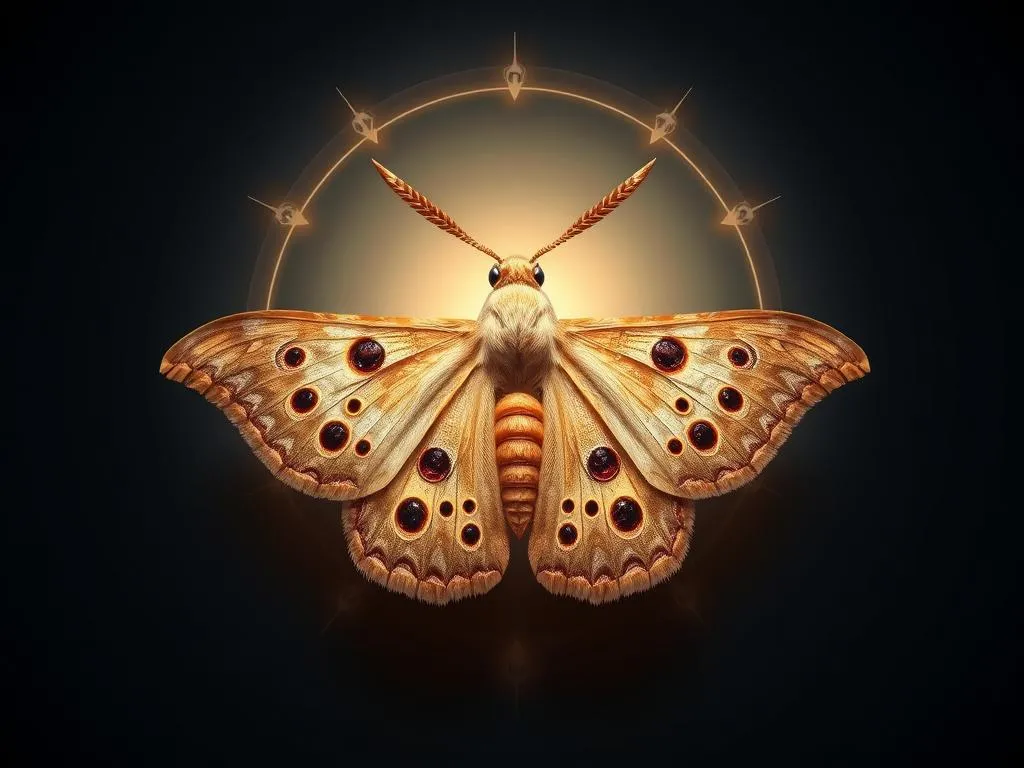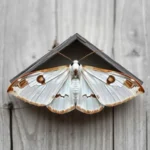The Enigmatic Saturniidae Moth: Symbolism and Spiritual Insights

Disclaimer: Some images on this website are AI-generated artworks and may not accurately represent real animals.
The Saturniidae moth, often referred to as giant silk moths, holds a special place in the tapestry of nature, culture, and spirituality. With their striking appearance and profound symbolism, these creatures offer insights into transformation, intuition, and our connection to the natural world. In this exploration, we will delve into the unique characteristics of the Saturniidae family, their cultural significance, and the deep meanings they carry in dreams and modern interpretations.
Understanding the Saturniidae Moth
Overview of Saturniidae Family
The Saturniidae family comprises some of the largest and most vibrant moths in the world. Found in various habitats across the globe, these moths are celebrated for their impressive size, with wingspans that can exceed a foot in some species. Their colors range from muted browns and greens to dazzling blues, oranges, and yellows, often adorned with intricate patterns that mimic natural elements.
| Physical Characteristics | Description |
|---|---|
| Size | Wingspans up to 12 inches (30 cm) |
| Colors | Varied – includes browns, greens, blues, and yellows |
| Patterns | Intricate designs, often resembling eyes or natural elements |
| Habitat | Found in temperate and tropical regions worldwide |
| Life Cycle | Egg, larva (caterpillar), pupa (cocoon), adult moth |
The life cycle of the Saturniidae moth is a fascinating journey of metamorphosis. Starting as tiny eggs, they hatch into caterpillars that feed voraciously on leaves. After several molts, they enter the pupal stage, where they undergo significant transformation within a silk cocoon. Finally, they emerge as magnificent adult moths ready to continue the cycle of life.
Cultural Significance
Throughout history, the Saturniidae moth has captivated the human imagination. Various cultures have ascribed different meanings to these creatures, often viewing them as symbols of transformation, rebirth, and the beauty of nature. In many indigenous communities, these moths are celebrated during seasonal festivals, representing the cyclical nature of life.
Myths and folklore abound, with stories depicting the Saturniidae moth as a guide for souls transitioning between worlds. In some traditions, these moths are believed to carry messages from ancestors or spiritual realms, reinforcing their significance as symbols of connection to the divine.

Symbolism & Spiritual Meaning
Transformation and Change
One of the most profound aspects of Saturniidae moth symbolism is its connection to transformation and personal growth. The metamorphosis from caterpillar to moth serves as a powerful metaphor for change in our own lives. Just as the caterpillar sheds its old skin to emerge as a beautiful moth, we too can embrace periods of change as opportunities for growth.
This symbolism resonates deeply during times of transition, encouraging individuals to let go of old patterns and embrace new beginnings. The Saturniidae moth reminds us that transformation, while often challenging, is essential for our evolution and personal development.
Connection to Nature
The Saturniidae moth also embodies a profound connection to the natural world. As a symbol of harmony, these moths remind us of the intricate web of life in which we all exist. Their presence in the ecosystem highlights the importance of biodiversity and our role in nurturing the environment.
Spiritually, the Saturniidae moth calls us to reconnect with nature. It encourages mindfulness and an appreciation for the beauty that surrounds us. By aligning ourselves with the rhythms of nature, we can find balance and harmony in our own lives.
Intuition and Insight
Beyond transformation and nature, the Saturniidae moth is associated with heightened intuition and psychic abilities. Many spiritual practitioners believe that encountering this moth can serve as a sign to pay attention to our inner voice and instincts. The delicate and ethereal nature of the moth represents the subtle energies that guide us through life’s challenges.
As a symbol of insight, the Saturniidae moth encourages us to trust our gut feelings and embrace our intuitive capabilities. This connection to the spiritual realm offers guidance and clarity, helping us navigate the complexities of our journey.
Saturniidae Moth in Dreams
Common Dream Interpretations
Dreaming of a Saturniidae moth can carry significant symbolic messages related to transformation and intuition. These dreams often reflect a process of change in the dreamer’s life, signaling a need for self-reflection and growth.
| Dream Scenario | Interpretation |
|---|---|
| Flying | Freedom and exploration of new opportunities |
| Resting | Need for stillness and contemplation |
| Metamorphosing | Embracing personal transformation and new beginnings |
Seeing a Saturniidae moth in a dream can signify the dreamer’s readiness to embark on a new chapter or phase in life. It encourages individuals to embrace change and harness their inner strength.
Dream Scenarios
Different scenarios involving Saturniidae moths can provide additional insights into our waking life situations. For example:
-
Flying: Dreaming of a Saturniidae moth soaring gracefully through the air may symbolize the freedom to explore new paths and opportunities. It suggests a time of liberation from constraints and encourages the dreamer to follow their aspirations.
-
Resting: If the moth is seen resting, it could indicate a need for self-care and introspection. This scenario encourages the dreamer to take a step back and evaluate their current situation, allowing time for reflection and rejuvenation.
-
Metamorphosing: Witnessing the moth undergo metamorphosis in a dream can be a powerful symbol of personal transformation. It signifies the dreamer’s readiness to embrace change and develop into their true self.
These dream scenarios reveal the multifaceted nature of the Saturniidae moth’s symbolism, reflecting our innermost thoughts and desires.
Modern Interpretations
Contemporary Symbolism
In today’s spiritual landscape, the Saturniidae moth has found its place as a symbol of personal growth and spiritual awakening. Many contemporary practices incorporate the symbolism of this moth into meditation and mindfulness exercises. Its essence serves as a reminder to embrace change and trust one’s intuition.
Meditation practices centered around the Saturniidae moth can help individuals connect with their inner selves, fostering a deeper understanding of their life journey and the transformations they are undergoing.
Saturniidae Moth in Art and Literature
The allure of the Saturniidae moth has also inspired artists and writers throughout the ages. In contemporary art, these moths are often depicted in vibrant colors and intricate designs, symbolizing beauty and transformation. Their presence in poetry often conveys themes of fleeting beauty and the cycle of life.
In popular culture, the Saturniidae moth serves as a motif representing change, mystery, and the unknown. Its unique characteristics and symbolism continue to resonate with audiences, reinforcing its place in the collective consciousness.
Key Takeaways
- The Saturniidae moth symbolizes transformation, personal growth, and new beginnings.
- It represents a deep connection to nature and the importance of ecological harmony.
- The moth is associated with heightened intuition, guiding individuals through life’s challenges.
- Dreaming of a Saturniidae moth often signifies personal transformation and a call to embrace change.
- Incorporating the moth’s symbolism into daily life can foster a deeper understanding of one’s journey.
Practical Applications
To harness the energy of the Saturniidae moth for personal transformation, consider the following practices:
- Journaling: Reflect on your personal transformations and the changes you wish to embrace. Write about your experiences and insights to gain clarity.
- Nature Walks: Spend time in nature to connect with the rhythms of the earth. Observe the beauty around you and appreciate the interconnectedness of all living beings.
- Meditation: Incorporate visualizations of the Saturniidae moth into your meditation practice. Focus on its symbolism of transformation and intuition, allowing it to guide you on your journey.
- Creative Expression: Engage in art or writing that reflects the themes of transformation and growth. Let the moth inspire your creative process.
Conclusion
The Saturniidae moth serves as a powerful symbol of transformation, intuition, and our connection to the natural world. Its enchanting presence invites us to embrace change and explore the depths of our inner selves. By understanding the symbolism of this moth, we can cultivate personal growth, navigate life’s challenges, and find harmony within ourselves and the environment.
As we continue to explore the connections between nature and our personal journeys, let the Saturniidae moth be a guiding light, reminding us of the beauty and potential that lies within change.







